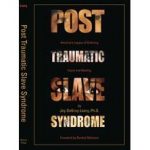 Dr. Joy DeGruy (formerly Dr. Joy DeGruy Leary), author of Post Traumatic Slave Syndrome: America’s Legacy of Enduring Injury and Healing, is a member of the Bahá’í faith community. Understanding this context breathes deeper meaning into Dr. DeGruy’s work than I would have had without this knowledge.
Dr. Joy DeGruy (formerly Dr. Joy DeGruy Leary), author of Post Traumatic Slave Syndrome: America’s Legacy of Enduring Injury and Healing, is a member of the Bahá’í faith community. Understanding this context breathes deeper meaning into Dr. DeGruy’s work than I would have had without this knowledge.
I recently spent a week with a family in Southern California that is close friends with Dr. DeGruy and are fellow Bahá’ís. We had dinner twice with Dr. DeGruy’s brother, who is also Bahá’í. I finished reading PTSS just prior to this visit. I was given an introduction to a religion I had heard of but knew little about. The faith’s founder, Bahá’u’lláh (1817-1892), was a Persian nobleman from Tehran who left his life of comfort to take his place as a messenger of God. His core message was one of unity. He taught that the time has arrived for the uniting of all peoples into a peaceful and integrated global society.
I agree. So how do we achieve this worthy goal? A key stumbling block is our “birds of a feather” isolation from each other and our lack of understanding of people, cultures, and religions who differ from us and our beliefs.
It is clear that Post Traumatic Slave Syndrome was written in particular for American’s of African descent. This is also an important book for people of European descent to read both to understand more about black people in America and the historic traumas they have endured and inherited, and to understand more about ourselves and the impact this same history has on the way we walk in the world today.
Dr. DeGruy writes about the negative self-images, perceptions and behaviors that many African American people adopt. “…what is not often addressed is the role our history has played in producing these negative perceptions, images, and behaviors.” She discusses the physical, emotional, psychological, and spiritual traumas that enslaved African people endured for hundreds of years in this country, that their descendants continued to endure for a century after the Civil War, and how that trauma continues to impact people of color today.
I’ve written about trauma before. I’ve traveled to Eastern Mennonite University in Virginia to study trauma in the STAR program (Strategies for Trauma Awareness and Resilience). I’m specifically interested in the historic trauma of enslavement and the continuing impact that it has on descendants of the enslaved, the enslavers, and on American society in general. The impacts are significant. We have a lot of work to do to achieve healing. Post Traumatic Slave Syndrome is an important book to help readers understand this.
W.E.B. Dubois wrote in 1903 that “…the problem of the Twentieth Century is the problem of the color-line.” Sadly, this continues to be true. More significant is that for the most part we as a nation have resisted taking full responsibility for our history of enslavement and repairing the damage. Dr. DeGruy accurately points out that, consequently, very little understanding exists between black and white America today.
Building that understanding takes time. It takes a commitment to gather together at the table and staying at the table even when things get awkward and challenging. It takes a willingness to learn about “the other”.
There is no single prescription for protecting people against racism, bigotry and hatred; there is no one-shot inoculation against intolerance or fanaticism. However, it appears that educating people to understand that these things do exist, and about the manner in which they are manifested, can be helpful to those who come face to face with them.”
You may not agree with all of Dr. DeGruy’s theories or conclusions. But I guarantee she will help you think more deeply about issues that are critical to your humanity.

This post traumatic slave syndrome is a little hard to grasp and is a new term for me. I think racism is a really bad disease. It cannot be cured unless we unite our efforts on a global level. microsoft-chat.com